How to make the perfect porchetta
The Italian version of hog roast, stuffed with garlic and herbs and generously salted, is utterly sublime. But lacking consensus on how to prepare it, I've had to spend a month testing slow-cooked pork and salty crackling The perfect porchetta.
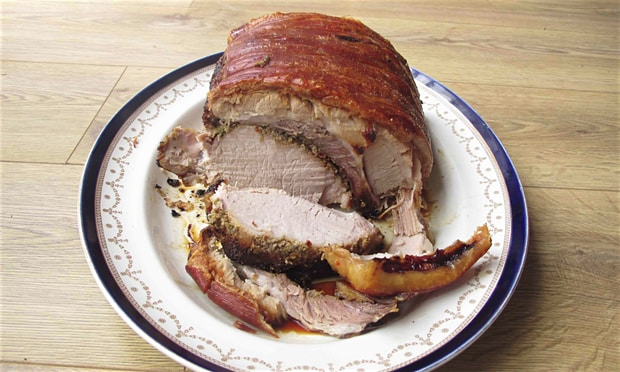
The perfect porchetta. Photograph: Felicity Cloake for the Guardian
Like most right-thinking omnivores, I love a hog roast – insincere apologies to any vegetarians still reading, but I'm rarely happier than when clutching a white roll overflowing with tender meat and crispy fat in my greedy paw. However, at the risk of hitting our national pride right where it hurts (the roast meat department), I prefer the Italian version.
It pops up in similar places ("porchetta trucks are fixtures at every festival, fair or sagra – local fete – parked in the middle of the benign pandemonium", as Rachel Roddy notes in her lovely book Five Quarters: Recipes and Notes from a Kitchen in Rome, while the Giancarlo and Katie Caldesi love it so much "we asked our local butcher to bring his porchetta van to our wedding") but, while Britain has long had a reputation for plainness in matters meat, porchetta has been given the fancy Italian treatment, stuffed with garlic and herbs, generously salted and served in robustly chewy rolls. If our hog roast is great, I'm afraid theirs is utterly sublime.
But, as with many classic Italian recipes, there's very little agreement on the best way to prepare it – as one desperate reader, appetite whetted by a holiday in Rome, discovered when he attempted to recreate the experience at home. "My Google attempts to find porchetta recipes bring up many different methods and cuts of pork," he writes – a cry for help I simply couldn't ignore.
Spend a week eating soft, juicy slow-cooked pork and salty crackling? It's a tough job, but Keith Kennedy, I've done it for you.
Meat
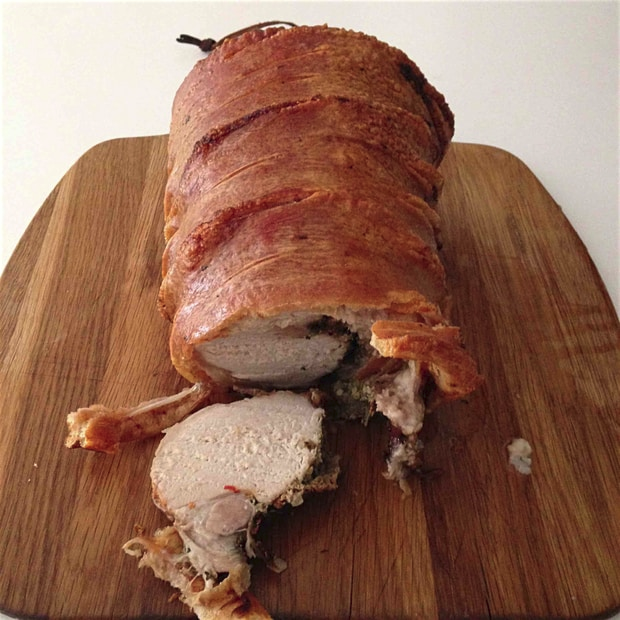
Rachel Roddy's porchetta. Photograph: Felicity Cloake for the Guardian
Traditionally, porchetta is, like our own noble hog roast, a nose to tail affair, in which a whole pig is deboned and roasted on a spit. Having briefly considered employing the dog as a "turnspit" terrier, I decided this was probably not the most practical option for those hoping for a taste of Tuscany closer to home.
Fortunately, though the River Cafe Classic calls for an 8kg piglet, the other recipes I try are more modest in their scope. Roddy explains that a porchetta cut is "the belly with the ribs removed and attached to the loin". Having gorged myself silly on her version at the launch of said book, I'm more than prepared to sweet talk my butcher into this unfamiliar cut to try the recipe that follows.
He's more familiar with the one called for in Richard H Turner's book Hog (perhaps unsurprisingly, given their names are both above the door): a pork loin rolled up inside a slab of boneless belly. Tim Hayward also calls for a "pork middle" in his new book, The DIY Cook, but suggests butterflied leg or boned shoulder as an alternative (I go for the latter on the basis of its higher fat content), and Katie Caldesi and J Kenji López-Alt, of US website Serious Eats, both opt for pork belly alone.
The latter explains his decision to ditch the loin thus: "My guess is that at the time porchetta was invented, hogs hadn't yet been bred to have large, lean loins, and thus there wasn't as big a distinction between the belly and loin sections. Both would have had plenty of fat and connective tissue, making both parts totally tasty even when cooked to a higher temperature." These days, however, "we all know that pork belly ... is the king of pork cuts, and that pork is the king of meats, and that meats are the masters of the universe. This makes eating an all-belly porchetta somewhat akin to consuming an aromatic, crispy, salty slab of awesome seasoned with He-Man."
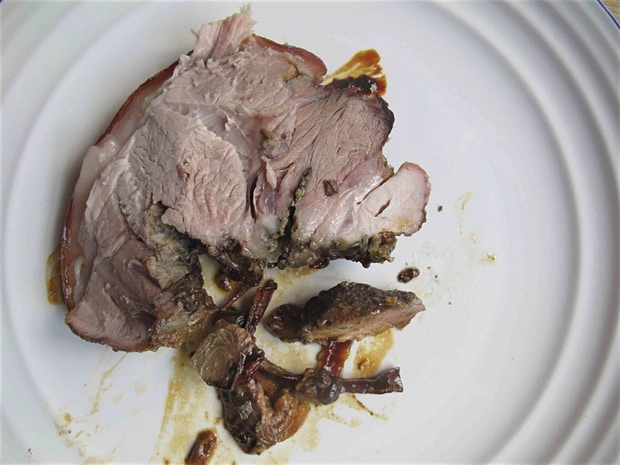
Tim Hayward's, made from 'pork middle'. Photograph: Felicity Cloake for the Guardian
Having eaten quite a lot of the stuff over the last month, I'd venture so far as to suggest all porchetta falls into this category; every cut I try is, as López-Alt would no doubt put it, "freaking delicious". Forced into critical mode, however, those who have generously assembled to help me out with the judging plump for the traditional belly-and-pork combination – the shoulder, though tender, can't really compete with belly in the tasty fat department, but without the meatier loin, it's almost too much of a good thing – a little balance is welcome.
A convenient truth: it's impossible to make a small amount of porchetta, because you need a piece wide enough to roll up. That said, as López-Alt notes, it's easy enough to cut the roll before cooking and freeze half for later.
The stuffing
The Italian job starts with the stuffing – a mixture of garlic, generous quantities of salt, herbs (Roddy and Hayward use rosemary, Turner thyme, and Caldesi rosemary and sage) and spices (black pepper but occasionally chilli flakes, too, as in Roddy and López-Alt's recipes). My testers are divided between rosemary and thyme, finding sage too "wintery" – I come down on the side of the almost aggressively aromatic charms of the former, but those with subtler palates may prefer thyme – and to omit the chilli flakes, though I do think they're a useful counterpoint to the richly fatty meat.
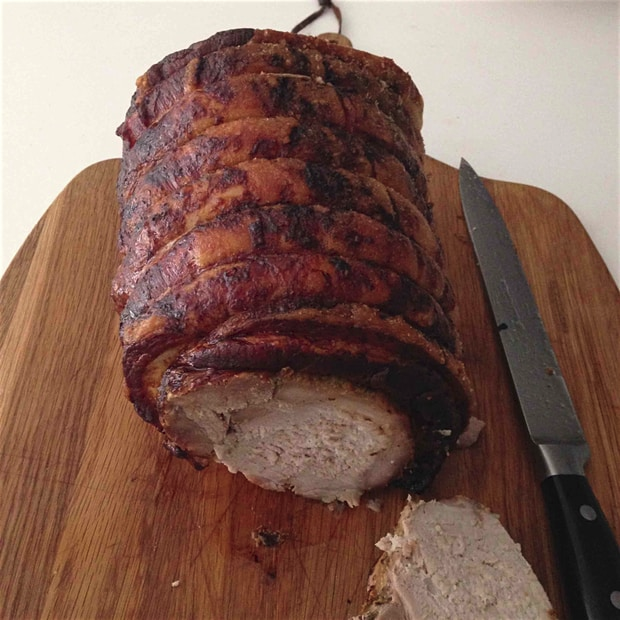
Richard Turner's, from his book Hog. Photograph: Felicity Cloake for the Guardian
López-Alt, Hayward, Roddy and Turner also use fennel, the latter two in the form of wild pollen, which Roddy notes was "traditionally foraged, therefore free. Nowadays, it has become rather fashionable and very expensive, which I think negates the beauty of it." I'm inclined to agree; lovely as it is, the sweet aniseed flavour comes across just as well in the plant's far cheaper seeds. Hayward also includes lemon zest, which, well as it goes with pork, would be overegging the flavour pudding in my version.
Turner makes a kind of paste with his aromatics, mixing them with lard and a little white wine before rubbing them into the meat. Initially, I'm sceptical (as if the dish needs any more fat), but it does seem to bring the flavours together somehow, as well as making application easier. (Scoring or stabbing the flesh, as López-Alt, Caldesi and Turner recommend, helps the salt, in particular, get to work.)
Preparation
In a concession to health, however, I'm going to forgo oiling the skin of the joint, as Caldesi suggests – in fact, it doesn't even need rubbing with baking powder, whatever López-Alt reckons; as long as you dry the skin out, preferably in the fridge overnight like Roddy, you'll be rewarded with "dark gold skin crisp enough to cut your lip".
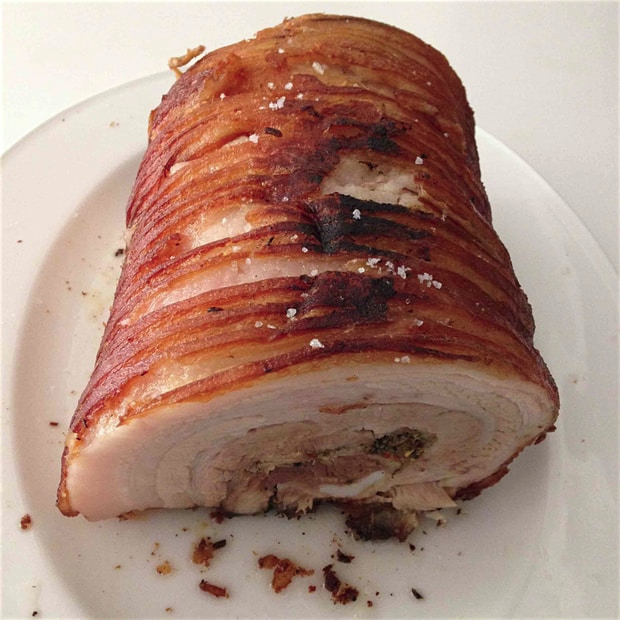
Kenji López-Alt's version ... 'an aromatic, crispy, salty slab of awesome seasoned with He-Man'. Photograph: Felicity Cloake for the Guardian
Roasting
This is the single most important aspect of the dish. Hayward cooks his low and slow, at 120C, while Caldesi goes for a steady 180C, with a bain marie to keep it juicy. Turner starts off at 200C, then after an hour, turns the oven down to 160C and adds pork stock. Roddy starts at 160C, and then cranks the temperature up to maximum for the final 30 minutes. They're all pleasingly juicy, but the Turner and Roddy varieties boast the best combination of tender meat and crisp skin – with Roddy scooping the crackling crown by some margin.
López-Alt goes for broke, vacuum-packing the joint, then cooking it sous vide at 68.3C for 36 hours before deep-frying it to a deep burnished gold. This, it cannot be denied, is a faff. A massive faff. Having a piece of pig simmering quietly on the work surface for a day and a half is fine, but frying it in a wok brimming with oil is not something I would recommend to anyone sane – the results are sublimely, wonderfully delicious, but my nerves, and my kitchen floor, may never be the same again. This stuff almost makes the rest look like health food.
Gravy?
Traditionally, as far as I'm aware, porchetta does not come with any sort of sauce – spit-roasted meat is generally basted with its own juices. Baking it in the oven, however, opens up such a possibility, which it would be churlish to ignore. Indeed, López-Alt's gravy, made with the juices collected in the vacuum bag during its dip in the water bath; and Turner's, made with the pork stock the meat is cooked in, go down very well with my testers.
Clearly, given we're talking pork belly, you'll need to skim off the fat before use, but add a little more white wine, and Roberto's your uncle. Think of it as a little British contribution to the noble Italian tradition of porchetta.
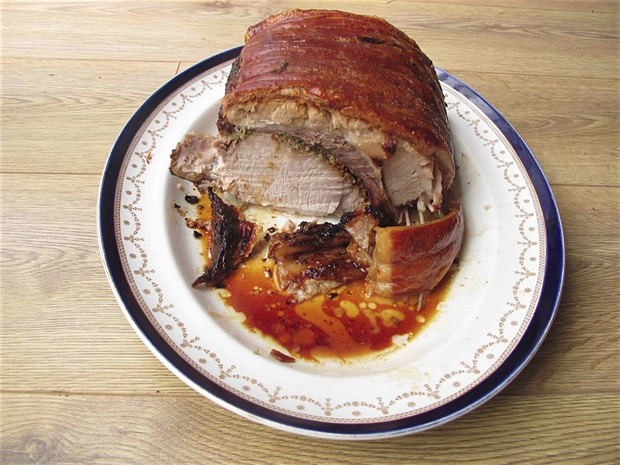
The finished, perfected article. Photograph: Felicity Cloake
(serves 6-8)Combine the seasoning ingredients into a smooth paste. Place the pork belly on a clean, flat surface, score the flesh, then rub the paste into the meat with your hands. Sit the loin long-side parallel to the shorter side of the belly, and then roll up tightly.
Tie up tightly with butcher's string at about 5cm intervals, and leave to sit, uncovered in the fridge, for at least 8 hours. Bring back to room temperature before cooking.
Heat the oven to 160C. Pat the meat as dry as possible with kitchen paper and put on a rack in a roasting tray. Roast for 4 hours, then turn the oven up as high as it will go and roast for another 30 minutes, or until the crackling is golden brown (keep an eye on it).
Remove from the oven and allow to rest, uncovered for 30 minutes. If you're making gravy, remove the meat and rack from the tray and skim off the fat. Return the rest of the juices to the pan along with the wine and put on a medium heat. Stir well and season to taste.
Carve the pork into slices. Stuff into rolls and drizzle with gravy, if using.
Porchetta v hog roast: which has the edge in the clash of the crackling? Can either be made with anything less than a whole pig – and has anyone tried the traditional version at home?
